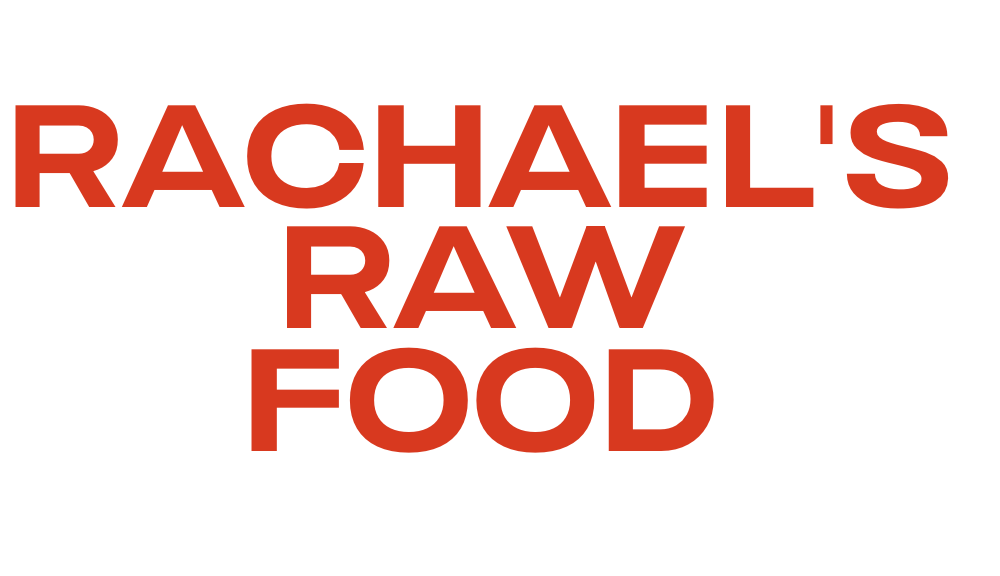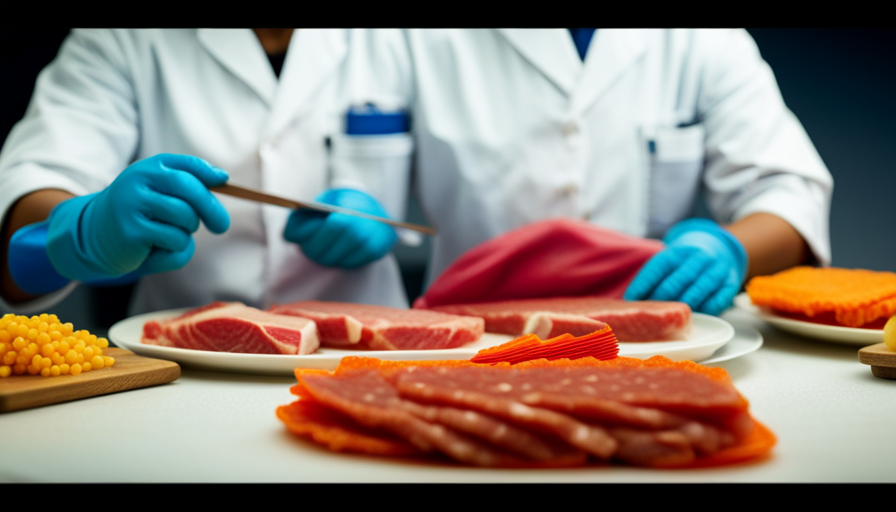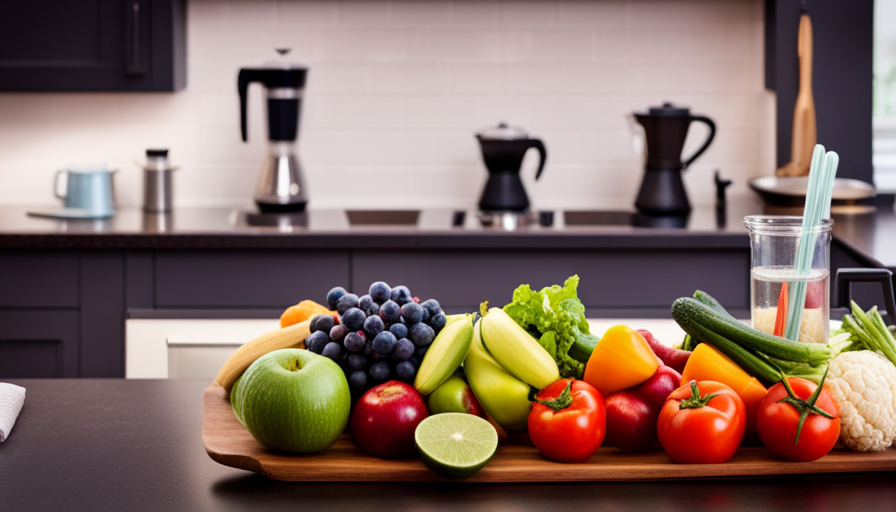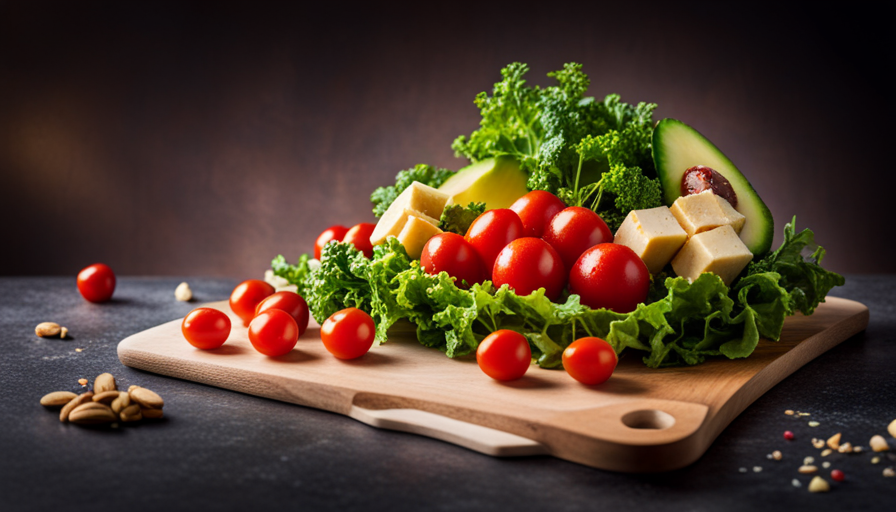Picture yourself in a busy kitchen, filled with sizzling pans and the scent of delectable food. As a food handler, your main focus is to guarantee that the meals you create are not only flavorful but also safe to eat.
One crucial aspect of food safety is preventing cross-contamination, especially when handling raw meat and ready-to-eat food. Cross-contamination occurs when harmful bacteria from one food item are transferred to another, putting consumers at risk of foodborne illnesses.
In this article, I will guide you through essential measures that food handlers can take to prevent cross-contamination in the kitchen. From using separate cutting boards and utensils to practicing proper hand hygiene, each step plays a vital role in maintaining the integrity of our meals.
By following these guidelines, you can confidently create mouthwatering dishes while ensuring the safety and well-being of your customers.
So let’s dive in and explore the world of cross-contamination prevention in the kitchen!
Key Takeaways
- Use separate cutting boards and utensils for raw meat and ready-to-eat food.
- Store raw meat in leak-proof containers on the bottom shelf of the refrigerator to prevent contamination.
- Regularly wash and sanitize cutting boards and utensils used for raw meat.
- Practice proper hand hygiene, including thorough handwashing and wearing gloves, to prevent cross-contamination.
Understand the Risks of Cross-Contamination
Understanding the risks of cross-contamination is crucial for food handlers, as it can mean the difference between serving safe, delicious meals and potentially causing harmful foodborne illnesses. Cross-contamination occurs when harmful bacteria or other microorganisms are transferred from one surface or food to another.
It can happen in various ways, such as through direct contact, airborne transfer, or through contaminated utensils and equipment. Recognizing potential sources of cross-contamination is essential. Raw meat, especially poultry and seafood, is a common source of harmful bacteria like Salmonella and Campylobacter. These bacteria can easily contaminate other foods if proper precautions are not taken.
Other potential sources include unwashed fruits and vegetables, contaminated water, and even dirty hands. To prevent cross-contamination, food handlers should use separate cutting boards and utensils for raw meat and ready-to-eat food. This helps minimize the risk of bacteria spreading from raw meat to other foods. By using different boards and utensils, it ensures that any harmful bacteria present on raw meat doesn’t come into contact with ready-to-eat foods like fruits, vegetables, or bread.
This simple step is a critical part of maintaining food safety and protecting the health of consumers.
Use Separate Cutting Boards and Utensils
To maintain hygiene in your kitchen, you can ensure that you have separate cutting boards and utensils for different ingredients, ensuring that no flavors or bacteria transfer between them. This is crucial when handling raw meat and ready-to-eat food to prevent cross-contamination.
Here are some key points to consider:
-
Preventing contamination through proper storage:
- Store raw meat in leak-proof containers on the bottom shelf of the refrigerator to avoid any drips onto other foods.
- Keep ready-to-eat food covered and separate from raw meat to minimize the risk of bacteria transfer.
-
Implementing food safety protocols:
- Use different colored cutting boards for raw meat and ready-to-eat food to visually distinguish them.
- Wash cutting boards and utensils with hot, soapy water after each use and sanitize them regularly.
- Consider using disposable cutting boards or cutting mats for raw meat to eliminate the need for cleaning.
By following these guidelines, you can significantly reduce the risk of cross-contamination in your kitchen. However, it’s essential to remember that proper hand hygiene is also crucial in preventing the spread of bacteria. So, let’s move on to the next section and talk about how to practice proper hand hygiene.
Practice Proper Hand Hygiene
Make sure you’re washing your hands properly to maintain a clean and safe kitchen environment. Proper hand hygiene is crucial when handling raw meat and ready-to-eat food to prevent cross-contamination.
To effectively wash your hands, wet them with warm water and apply soap. Rub your hands together vigorously for at least 20 seconds, making sure to clean the front and back of your hands, between your fingers, and under your nails. Rinse your hands thoroughly and dry them with a clean towel or air dryer.
In addition to handwashing, wearing gloves is also important when handling raw meat and ready-to-eat food. Gloves act as a barrier between your hands and the food, reducing the risk of transferring harmful bacteria. When wearing gloves, make sure they’re clean and in good condition. Change gloves regularly, especially when switching between different tasks or after handling raw meat.
By practicing proper handwashing techniques and wearing gloves, you can significantly minimize the risk of cross-contamination in the kitchen. Remember to store raw meat and ready-to-eat food separately to further prevent the spread of bacteria. This will be discussed in the next section.
Store Raw Meat and Ready-to-Eat Food Separately
Contrary to popular belief, it’s a great idea to keep raw meat and ready-to-eat items stored separately in order to maintain a truly unique and unforgettable dining experience. To prevent cross-contamination risks and ensure food safety, proper storage techniques are crucial. Here are some key points to consider:
-
Use separate containers or sealable bags: This helps to prevent any juices from raw meat, which may contain harmful bacteria, from coming into contact with ready-to-eat food.
-
Store raw meat on lower shelves: By placing raw meat on the bottom shelf of the refrigerator or in a separate section, you can prevent any accidental drips or leaks from contaminating other food items.
-
Label and date containers: Properly labeling and dating containers can help you keep track of when food was stored and ensure that it’s consumed within a safe timeframe.
-
Clean and sanitize storage areas: Regularly clean and sanitize the areas where raw meat is stored to eliminate any potential bacteria buildup.
By implementing these proper storage techniques, you can greatly reduce the risk of cross-contamination and ensure the safety of your food.
In the next section, we’ll discuss how to clean and sanitize surfaces and equipment to further prevent any potential contamination.
Clean and Sanitize Surfaces and Equipment
When cleaning and sanitizing surfaces and equipment, you can ensure a sparkling and germ-free environment for your culinary creations. Proper cleaning techniques are crucial to prevent cross-contamination.
First, it’s important to wash your hands thoroughly before and after handling raw meat and ready-to-eat food.
Next, clean all surfaces, such as cutting boards and countertops, with hot, soapy water to remove any visible debris.
Then, sanitize the surfaces using a mixture of bleach and water or a food-grade sanitizer. Pay special attention to areas that come into direct contact with raw meat, such as knives and utensils, and make sure they’re properly cleaned and sanitized.
In addition to regular cleaning, proper equipment maintenance is essential. Regularly inspect and clean equipment, such as refrigerators and grills, to prevent the buildup of food residues and bacteria. Follow the manufacturer’s instructions for cleaning and sanitizing, and replace any worn or damaged equipment as needed. By maintaining clean and well-functioning equipment, you can reduce the risk of cross-contamination.
As you clean and sanitize surfaces and equipment, it’s important to remember that this is just one step in preventing cross-contamination. The next crucial step is to cook food to appropriate temperatures, ensuring that it’s safe for consumption.
Cook Food to Appropriate Temperatures
To ensure a delicious and safe culinary experience, it’s crucial to cook your ingredients to the right temperatures. Cooking food to appropriate temperatures kills harmful bacteria and helps prevent foodborne illnesses. One effective way to determine if your food is cooked properly is by using a food thermometer. This handy tool allows you to accurately measure the internal temperature of the food, ensuring that it reaches the necessary level to destroy any potential pathogens.
To give you a better understanding of the appropriate cooking temperatures for different types of food, refer to the table below:
| Food | Minimum Internal Temperature |
|---|---|
| Poultry (chicken, turkey) | 165°F (74°C) |
| Ground Meat (beef, pork) | 160°F (71°C) |
| Seafood | 145°F (63°C) |
By following these guidelines and using a food thermometer, you can be confident that your food is cooked to the right temperatures, reducing the risk of cross-contamination and foodborne illnesses.
Avoid using the same plate or tray for raw and cooked food to further prevent cross-contamination.
Avoid Using the Same Plate or Tray for Raw and Cooked Food
Make sure you keep your cooking area clean and organized by using separate plates or trays for your ingredients before and after they’re cooked. This is an essential step in preventing cross-contamination when preparing raw meat and ready-to-eat food.
Proper food storage techniques play a crucial role in maintaining food safety. It’s important to store raw meat in a separate container or on a separate tray to avoid any potential contact with other foods. This helps prevent the spread of harmful bacteria that may be present in raw meat.
Additionally, temperature control is of utmost importance when it comes to food safety. Raw meat should always be stored at the appropriate temperature in the refrigerator to inhibit the growth of bacteria. By using separate plates or trays for raw meat and cooked food, you’re minimizing the risk of cross-contamination and ensuring that each type of food is handled and stored properly.
As we move on to the next section about keeping raw meat refrigerated until ready to use, it’s important to remember that proper storage techniques and temperature control are key factors in maintaining food safety.
Keep Raw Meat Refrigerated until Ready to Use
Refrigerating raw meat until ready to use is vital for ensuring its freshness and reducing the risk of bacterial growth, which can lead to foodborne illnesses. Did you know that, according to a recent study, properly refrigerated meat can stay safe for up to five days?
Proper handling techniques and maintaining the right temperature are crucial in preventing cross-contamination when preparing raw meat and ready-to-eat food.
When it comes to raw meat, it should always be stored in the refrigerator at a temperature below 40°F (4°C) to slow down bacterial growth. This ensures that any harmful bacteria present in the meat do not multiply rapidly. It is important to keep raw meat in a sealed container or wrapped securely to prevent any juices from dripping onto other foods and causing contamination.
Additionally, it is essential to separate raw meat from ready-to-eat food items to prevent cross-contamination. Raw meat should be stored on the bottom shelf of the refrigerator to prevent any drips onto other foods. If possible, use separate compartments or drawers to further reduce the risk of cross-contamination.
By following proper handling techniques and maintaining the right temperature, we can greatly minimize the risk of cross-contamination. In the next section, we’ll explore the use of color-coded labels or containers for different types of food, another important step in preventing cross-contamination.
Use Color-Coded Labels or Containers for Different Types of Food
Did you know that using color-coded labels or containers for different types of food can be a fun and efficient way to organize your kitchen? Not only does it make it easier to locate specific items, but it also helps prevent cross-contamination when preparing raw meat and ready-to-eat food.
Here are some benefits of using color-coded labeling and separate containers:
-
Clear Identification: By assigning a specific color to each type of food, it becomes much easier to identify and differentiate between them. This reduces the risk of mistakenly using the wrong ingredients or utensils for different foods.
-
Enhanced Hygiene: Color-coded labels and containers promote good hygiene practices by ensuring that raw meat and ready-to-eat food are stored separately. This minimizes the chances of harmful bacteria from raw meat contaminating other foods.
-
Efficient Workflow: With color-coded organization, food handlers can work more efficiently. They can quickly locate the ingredients they need, reducing the time spent searching and minimizing the risk of cross-contamination during food preparation.
-
Training Aid: Color-coded labeling and containers can serve as a helpful training aid for new staff members. It visually reinforces the importance of keeping raw meat separate from ready-to-eat food and reinforces proper food safety practices.
By implementing color-coded labeling and separate containers, you can significantly reduce the risk of cross-contamination in your kitchen. However, it’s essential to also train and educate staff on cross-contamination prevention measures to ensure a safe food handling environment.
Train and Educate Staff on Cross-Contamination Prevention Measures
Ensure that your staff members are well-trained and educated on the measures to avoid the spreading of harmful elements in your kitchen. Staff training is crucial in preventing cross-contamination when preparing raw meat and ready-to-eat food. By providing comprehensive training, you can equip your employees with the knowledge and skills necessary to handle food safely and minimize the risks of cross-contamination.
Start by educating your staff on the different types of cross-contamination risks that can occur in the kitchen. Emphasize the importance of proper hand hygiene, including frequent handwashing with soap and water. Instruct them on the proper use of gloves and changing them regularly to prevent the transfer of bacteria from raw meat to ready-to-eat food.
Additionally, teach your staff about the proper cleaning and sanitization procedures for utensils, cutting boards, and surfaces that come into contact with raw meat. They should be aware of the potential hazards of using the same cutting board or knife for both raw meat and ready-to-eat food without proper cleaning and sanitizing in between.
Regularly reinforce these training measures through ongoing education and reminders. Conduct periodic evaluations to ensure that your staff is following the correct procedures and address any areas of improvement.
By investing in staff training and education, you can significantly reduce the risk of cross-contamination in your kitchen and maintain the safety and quality of your food.
Frequently Asked Questions
What are the potential consequences of cross-contamination between raw meat and ready-to-eat food?
The potential consequences of cross-contamination between raw meat and ready-to-eat food can be severe. It can lead to foodborne illnesses, such as salmonella or E. coli, which can cause symptoms like vomiting, diarrhea, and abdominal pain. These illnesses can be especially dangerous for vulnerable populations, such as the elderly or those with weakened immune systems.
To prevent cross-contamination, food handlers should practice proper hand hygiene, use separate cutting boards and utensils for raw and ready-to-eat foods, and store them separately in the refrigerator.
How often should cutting boards and utensils be replaced to ensure they are not harboring harmful bacteria?
Cutting board maintenance is crucial for hygienic food preparation. To ensure harmful bacteria don’t linger, I recommend regularly replacing cutting boards and utensils. The frequency depends on usage, but a general rule is to replace them every 1-2 years.
Regular inspection is key, looking for deep cuts, grooves, and stains that can harbor bacteria. Additionally, proper cleaning and sanitizing after each use will further reduce the risk of cross-contamination.
Stay vigilant to protect against foodborne illnesses!
Are there any specific hand hygiene techniques that are particularly effective in preventing cross-contamination?
Effective handwashing techniques are crucial in preventing cross-contamination. Thoroughly wash hands with warm, soapy water for at least 20 seconds. Pay special attention to areas like fingertips, nails, and between fingers. Use a nail brush if needed. Rinse hands thoroughly and dry with a single-use paper towel.
Avoid touching surfaces after washing to prevent recontamination. Regular handwashing is vital, especially before and after handling raw meat and ready-to-eat food. This ensures food safety and prevents the spread of harmful bacteria.
Can raw meat and ready-to-eat food be stored in the same refrigerator, as long as they are properly separated?
Yes, raw meat and ready-to-eat food should be stored separately in the refrigerator to prevent cross-contamination. Imagine a refrigerator divided into two sections: one for raw meat and the other for ready-to-eat food. This separation ensures that any potential bacteria or juices from the raw meat won’t come into contact with the ready-to-eat food, reducing the risk of foodborne illnesses. Properly sealing and labeling the raw meat also helps maintain this separation, ensuring the safety of the food.
How frequently should surfaces and equipment be cleaned and sanitized to prevent cross-contamination?
Surfaces and equipment should be cleaned and sanitized frequently to prevent cross-contamination. The frequency of cleaning depends on the level of use and potential for contamination. High-touch surfaces, such as cutting boards and utensils, should be cleaned and sanitized after each use.
Other surfaces, such as countertops and sinks, should be cleaned and sanitized at least once every four hours. Sanitization methods can include using hot water and detergent, followed by a sanitizing solution, or using a commercial sanitizer according to the manufacturer’s instructions.
How Does Storing Raw and Cooked Food Separately Help Prevent Cross-Contamination when Handling Raw Meat and Ready-to-Eat Food?
When handling raw meat and ready-to-eat food, storing raw and cooked food separately is crucial to prevent cross-contamination. This practice helps maintain the integrity of the ready-to-eat food and reduces the risk of harmful bacteria from raw meat spreading to cooked food.
Conclusion
In conclusion, preventing cross-contamination is crucial in ensuring the safety and quality of food. By understanding the risks involved and using separate cutting boards and utensils, we can significantly reduce the chances of contamination. Practicing proper hand hygiene and storing raw meat and ready-to-eat food separately are also essential steps.
Cleaning and sanitizing surfaces and equipment, avoiding the use of the same plate or tray for raw and cooked food, and keeping raw meat refrigerated until ready to use are also important measures. Using color-coded labels or containers and training staff on prevention measures further enhance food safety.
By implementing these measures, we can guarantee that our food is safe and free from any potential hazards. So, let’s stay vigilant and take all necessary precautions to protect our customers and ensure the highest standards of food handling.










